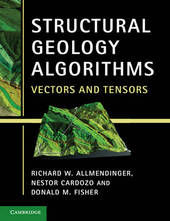
|
Structural Geology Algorithms: Vectors and Tensors
Paperback / softback
Main Details
| Title |
Structural Geology Algorithms: Vectors and Tensors
|
| Authors and Contributors |
By (author) Richard W. Allmendinger
|
|
By (author) Nestor Cardozo
|
|
By (author) Donald M. Fisher
|
| Physical Properties |
| Format:Paperback / softback | | Pages:302 | | Dimensions(mm): Height 247,Width 190 |
|
| Category/Genre | Applied mathematics
Geology and the lithosphere |
|---|
| ISBN/Barcode |
9781107401389
|
| Classifications | Dewey:551.8015181 |
|---|
| Audience | | Professional & Vocational | |
|---|
| Illustrations |
Worked examples or Exercises; 15 Tables, black and white; 40 Halftones, unspecified; 91 Line drawings, unspecified
|
|
Publishing Details |
| Publisher |
Cambridge University Press
|
| Imprint |
Cambridge University Press
|
| Publication Date |
1 December 2011 |
| Publication Country |
United Kingdom
|
Description
State-of-the-art analysis of geological structures has become increasingly quantitative but traditionally, graphical methods are used in teaching. This innovative lab book provides a unified methodology for problem-solving in structural geology using linear algebra and computation. Assuming only limited mathematical training, the book begins with classic orientation problems and progresses to more fundamental topics of stress, strain and error propagation. It introduces linear algebra methods as the foundation for understanding vectors and tensors, and demonstrates the application of geometry and kinematics in geoscience without requiring students to take a supplementary mathematics course. All algorithms are illustrated with a suite of online MATLAB functions, allowing users to modify the code to solve their own structural problems. Containing 20 worked examples and over 60 exercises, this is the ideal lab book for advanced undergraduates or beginning graduate students. It will also provide professional structural geologists with a valuable reference and refresher for calculations.
Author Biography
Richard W. Allmendinger is a structural geologist and a professor in the Earth and Atmospheric Sciences Department at Cornell University. He is widely known for his work on thrust tectonics and earthquake geology in South America, where much of his work over the past three decades has been based, as part of the Cornell Andes Project. Professor Allmendinger is the author of more than 100 publications and numerous widely used structural geology programs for Macs and PCs. Nestor Cardozo is an associate professor at the University of Stavanger, Norway, where he teaches undergraduate and graduate courses on structural geology and its application to petroleum geosciences. He has been involved in several multidisciplinary research projects to realistically include faults and their associated deformation in reservoir models. He is the author of several widely used structural geology and basin analysis programs for Macs. Donald M. Fisher is a structural geologist and professor at Pennsylvania State University, where he leads a Structural Geology and Tectonics research group. His research on active structures, strain histories and deformation along convergent plate boundaries has taken him to field areas in Central America, Kodiak Alaska, northern Japan, Taiwan and offshore Sumatra. He has been teaching structural geology to undergraduate and graduate students for more than 20 years.
Reviews'I like this book. The material covered, the level of detail and the inclusion of MATLAB scripts make this a timely, relevant and very useful textbook ... [it] will help structural geologists - of all levels - make that critical leap from purely geometrical analyses, through kinematics and into the underlying continuum mechanics of rock deformation. A worthy addition to your bookshelf.' Geological Magazine 'I highly recommend this book to all structural geology students and practitioners, as well as to earth scientists from a wide range of fields, who will benefit from this clear introduction of the principles and application of linear algebra in the analysis of commonly encountered vector and tensor quantities.' Roland Burgmann, University of California, Berkeley 'The book is suitable for numerate researchers and advanced undergraduates who are reasonably comfortable with mathematics ... it is essential in the twenty-first century that we have numerate geoscientists trained in quantitative techniques of structural geology ... The authors take care to describe the basics of tensor algebra as well as its application; this book is a solid foundation for understanding the mathematical analysis of how the Earth deforms.' John Wheeler, American Mineralogist
|